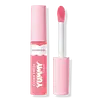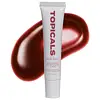What's inside
What's inside
 Key Ingredients
Key Ingredients

 Benefits
Benefits

 Concerns
Concerns

 Ingredients Side-by-side
Ingredients Side-by-side

Hydrogenated Polyisobutene
EmollientPolybutene
C12-15 Alkyl Benzoate
AntimicrobialTridecyl Trimellitate
EmollientEthylene/Propylene/Styrene Copolymer
Bis-Diglyceryl Polyacyladipate-2
EmollientButylene/Ethylene/Styrene Copolymer
Caprylyl Glycol
EmollientRicinus Communis Seed Oil
MaskingParfum
MaskingSilica Dimethyl Silylate
EmollientPentaerythrityl Tetra-Di-T-Butyl Hydroxyhydrocinnamate
AntioxidantTocopheryl Acetate
AntioxidantHelianthus Annuus Seed Oil
EmollientSodium Hyaluronate
HumectantStevia Rebaudiana Leaf/Stem Extract
MaskingEuterpe Oleracea Fruit Extract
Lycium Barbarum Fruit Extract
AstringentSambucus Nigra Fruit Extract
AstringentHydrogenated Castor Oil
EmollientTriethoxycaprylylsilane
CI 77891
Cosmetic ColorantCI 45410
Cosmetic ColorantCI 15850
Cosmetic ColorantIron Oxides
CI 19140
Cosmetic ColorantCI 77742
Cosmetic ColorantCI 42090
Cosmetic ColorantHydrogenated Polyisobutene, Polybutene, C12-15 Alkyl Benzoate, Tridecyl Trimellitate, Ethylene/Propylene/Styrene Copolymer, Bis-Diglyceryl Polyacyladipate-2, Butylene/Ethylene/Styrene Copolymer, Caprylyl Glycol, Ricinus Communis Seed Oil, Parfum, Silica Dimethyl Silylate, Pentaerythrityl Tetra-Di-T-Butyl Hydroxyhydrocinnamate, Tocopheryl Acetate, Helianthus Annuus Seed Oil, Sodium Hyaluronate, Stevia Rebaudiana Leaf/Stem Extract, Euterpe Oleracea Fruit Extract, Lycium Barbarum Fruit Extract, Sambucus Nigra Fruit Extract, Hydrogenated Castor Oil, Triethoxycaprylylsilane, CI 77891, CI 45410, CI 15850, Iron Oxides, CI 19140, CI 77742, CI 42090
Hydrogenated Polyisobutene
EmollientPolybutene
Jojoba Esters
EmollientCocos Nucifera Oil
MaskingHelianthus Annuus Seed Oil
EmollientEthylene/Propylene/Styrene Copolymer
Copernicia Cerifera Wax
Butylene/Ethylene/Styrene Copolymer
Glycerin
HumectantSodium Hyaluronate
HumectantHydrolyzed Sodium Hyaluronate
Skin ConditioningCeramide NP
Skin ConditioningCeramide AP
Skin ConditioningCeramide EOP
Skin ConditioningPhytosphingosine
Skin ConditioningPalmitoyl Tripeptide-38
Skin ConditioningCholesterol
EmollientTocopheryl Acetate
AntioxidantErgothioneine
AntioxidantStevia Rebaudiana Leaf/Stem Powder
Skin ConditioningPortulaca Pilosa Extract
Skin ConditioningSucrose Cocoate
EmulsifyingPanthenol
Skin ConditioningSodium Lauroyl Lactylate
EmulsifyingSilica
AbrasiveCarbomer
Emulsion StabilisingKaolin
AbrasiveOryza Sativa Bran Wax
Skin ConditioningXanthan Gum
EmulsifyingDimer Dilinoleyl Dimer Dilinoleate
EmollientTriisostearin
Skin ConditioningCetearyl Ethylhexanoate
EmollientOctyldodecanol
EmollientSorbitan Isostearate
EmulsifyingSorbitan Oleate
EmulsifyingWater
Skin ConditioningAroma
CI 77742
Cosmetic ColorantCI 17200
Cosmetic ColorantCI 45380
Cosmetic ColorantCI 77491
Cosmetic ColorantCI 77499
Cosmetic ColorantCI 77891
Cosmetic ColorantHydrogenated Polyisobutene, Polybutene, Jojoba Esters, Cocos Nucifera Oil, Helianthus Annuus Seed Oil, Ethylene/Propylene/Styrene Copolymer, Copernicia Cerifera Wax, Butylene/Ethylene/Styrene Copolymer, Glycerin, Sodium Hyaluronate, Hydrolyzed Sodium Hyaluronate, Ceramide NP, Ceramide AP, Ceramide EOP, Phytosphingosine, Palmitoyl Tripeptide-38, Cholesterol, Tocopheryl Acetate, Ergothioneine, Stevia Rebaudiana Leaf/Stem Powder, Portulaca Pilosa Extract, Sucrose Cocoate, Panthenol, Sodium Lauroyl Lactylate, Silica, Carbomer, Kaolin, Oryza Sativa Bran Wax, Xanthan Gum, Dimer Dilinoleyl Dimer Dilinoleate, Triisostearin, Cetearyl Ethylhexanoate, Octyldodecanol, Sorbitan Isostearate, Sorbitan Oleate, Water, Aroma, CI 77742, CI 17200, CI 45380, CI 77491, CI 77499, CI 77891
 Reviews
Reviews

Ingredients Explained
These ingredients are found in both products.
Ingredients higher up in an ingredient list are typically present in a larger amount.
We don't have a description for Butylene/Ethylene/Styrene Copolymer yet.
This ingredient is used to add a violet color to cosmetics.
It is created by reacting phosphoric acid, ammonium dihydrogen orthophosphate, and manganese dioxide.
Ci 77891 is a white pigment from Titanium dioxide. It is naturally found in minerals such as rutile and ilmenite.
It's main function is to add a white color to cosmetics. It can also be mixed with other colors to create different shades.
Ci 77891 is commonly found in sunscreens due to its ability to block UV rays.
Learn more about CI 77891We don't have a description for Ethylene/Propylene/Styrene Copolymer yet.
Helianthus Annuus Seed Oil is the oil derived from the seeds of a Sunflower. Sunflower seed oil is non-fragrant. It is an emollient, meaning it helps to soften the skin.
Sunflower seed oil contains many fatty acids. The fatty acids found in sunflower seeds include (from highest amount to least): linoleic acid, myristic acid, palmitic acid, stearic acid, arachidic acid, oleic acid, and linolenic acid.
These fatty acids help the skin create ceramides. Ceramides play a role in repairing the skin barrier.
Helianthus Annuus Seed Oil helps moisturize the skin. This in turn helps the skin look more rejuvenated and smoother.
Sunflowers are rich in vitamin E.
Historians believe Indigenous cultures of North America domesticated sunflowers before corn. Thus they relied on sunflower oil for a variety of uses. One such use is moisturizing skin and hair.
Sunflower seed oil may not be fungal acne safe. We recommend speaking with a professional if you have any concerns.
Learn more about Helianthus Annuus Seed OilHydrogenated Polyisobutene is a synthetic polymer. Polymers are compounds with high molecular weight. Hydrogenated Polyisobutene is an emollient and texture enhancer.
In one study, Hydrogenated Polyisobutene showed better skin hydration levels than Caprylic/Capric Triglyceride. As an emollient, it helps keep your skin soft and hydrated by trapping moisture in.
Hydrogenated Polyisobutene is often used as a mineral oil replacement.
Learn more about Hydrogenated PolyisobutenePolybutene is used to help control the viscosity of a product. This just means it helps adjusts the texture.
It is a polymer and does not get absorbed into the skin due to its large size.
Studies found this ingredient did not irritate skin in concentrations below 15%.
Learn more about PolybuteneSodium Hyaluronate is hyaluronic acid's salt form. It is commonly derived from the sodium salt of hyaluronic acid.
Like hyaluronic acid, it is great at holding water and acts as a humectant. This makes it a great skin hydrating ingredient.
Sodium Hyaluronate is naturally occurring in our bodies and is mostly found in eye fluid and joints.
These are some other common types of Hyaluronic Acid:
Learn more about Sodium HyaluronateTocopheryl Acetate is AKA Vitamin E. It is an antioxidant and protects your skin from free radicals. Free radicals damage the skin by breaking down collagen.
One study found using Tocopheryl Acetate with Vitamin C decreased the number of sunburned cells.
Tocopheryl Acetate is commonly found in both skincare and dietary supplements.
Learn more about Tocopheryl Acetate